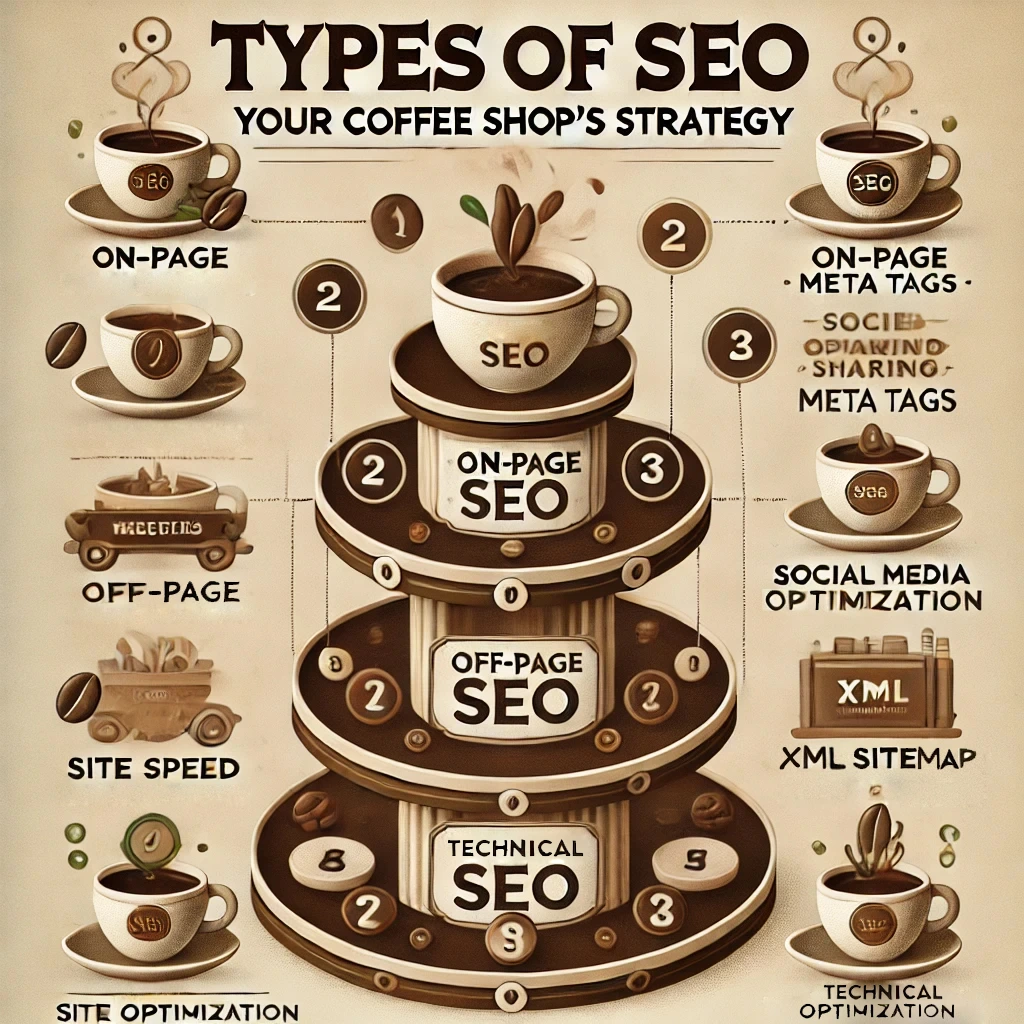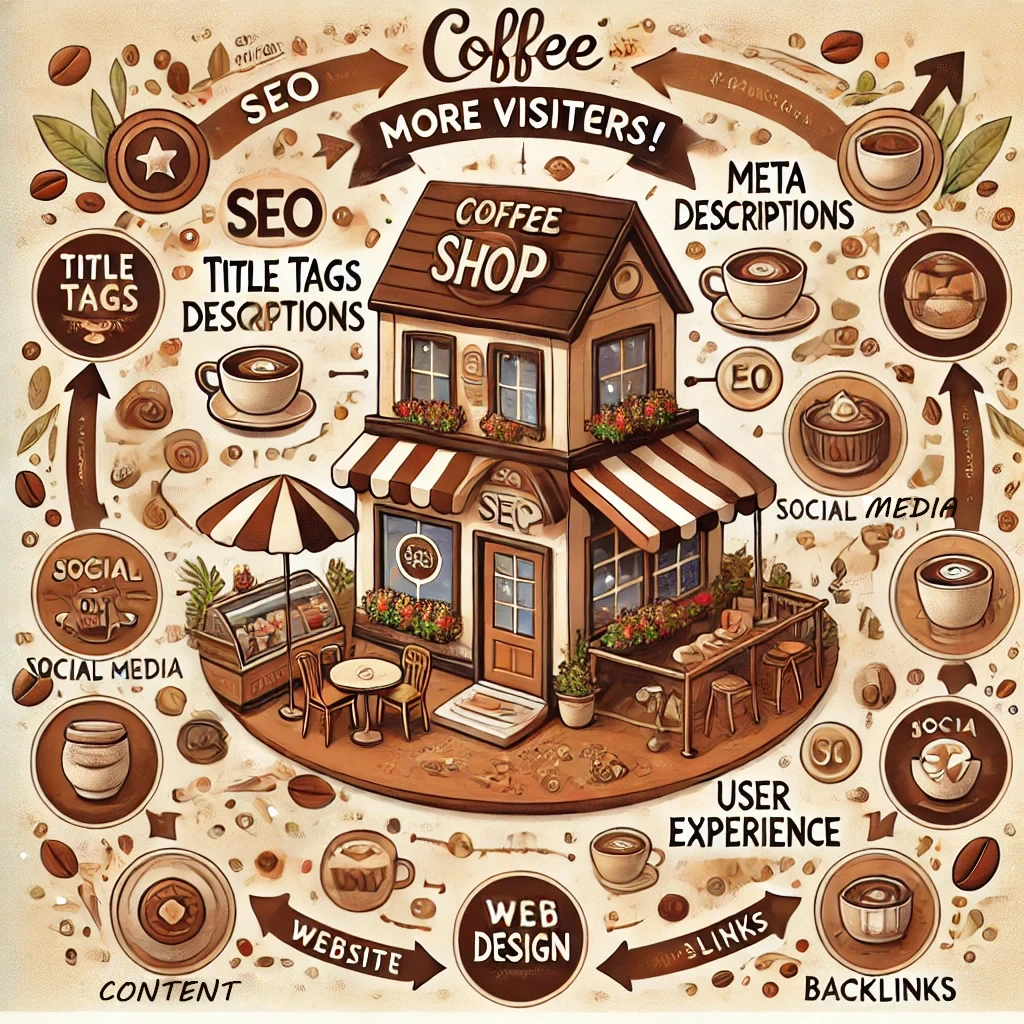Imagine you own a coffee shop in a busy city. Your shop serves the best coffee, but it’s tucked away on a quiet street with no signs pointing people to it. Even though your coffee is amazing, only a few customers stumble upon your shop by chance.
One day, a marketing expert walks in and offers advice. “You need to make your shop visible,” they say. “First, put up a big, clear sign outside. That’s like adding a good title to your website that tells search engines what it’s about.”
“Next, hand out flyers to people nearby,” they continue. “Think of this as sharing your content on social media or other websites to bring traffic back to your site, and don’t forget to decorate your shop so it’s welcoming and easy to navigate. That’s like optimising your website layout for a great user experience.”
“Finally, if customers love your coffee, they’ll tell their friends. That’s like backlinks—other websites vouching for your content by linking to it.” By following these steps, your coffee shop becomes the talk of the town. More people come, and your reputation grows.
SEO works the same way. It helps make your website easy to find and attractive to visitors, turning your little corner of the internet into a bustling hub.
What is SEO?
At its core, SEO is the practice of optimising your website to make it more visible on search engine results pages (SERPs). Think of search engines like Google as the main streets of the internet—and SEO is the strategy to make your website’s “shop” stand out to people walking by.
Why is SEO Important?
- Improved Visibility: Like putting up a clear, bright sign, SEO helps your website rank higher on SERPs, making it easier for people to find you.
- Increased Traffic: Just like more people discovering your coffee shop, SEO drives more visitors to your website.
- Cost-Effective Marketing: Unlike paid ads, SEO drives organic traffic—equivalent to word-of-mouth in the coffee shop analogy.
- Builds Credibility: High rankings signal trust and authority, just like a busy coffee shop signals good quality.

Types of SEO
To make your “shop” visible and successful, SEO has three main components:
1. On-Page SEO
This involves optimising elements on your website—similar to making the inside of your coffee shop welcoming and organised:
- Keywords: Like using the right description for your coffee, use relevant keywords in your content that people are searching for.
- Headings and Subheadings: These act as signboards for different sections, helping search engines understand your content better.
- Meta Tags: Think of these as the catchy taglines on your flyers, enticing people to visit. Meta Tags give search engines and users a quick snapshot of what your content is about, helping them decide to click.
- Image Optimisation: Just like displaying an attractive menu or decor, optimising images ensures they load quickly and enhance user experience.
2. Off-Page SEO
This focuses on promoting your “shop” outside its walls:
- Backlinks: Like happy customers recommending your shop, backlinks from trusted websites boost your credibility.
- Social Media Sharing: Hand out digital flyers by sharing your content on platforms like Instagram and LinkedIn.
- Guest Blogging: Publish content on other popular sites to bring visitors back to your website.
3. Technical SEO
This is about ensuring the foundation of your “shop” is solid:
- Site Speed: A fast-loading site is like a quick service counter—nobody likes to wait.
- Mobile Optimisation: Your site should look and work perfectly on mobile devices, like having takeaway options for customers on the go.
- XML Sitemaps: Help search engines navigate your site, just as clear shop maps help customers find what they need.

How to Get Started with SEO
Here’s how you can start optimising your website step by step:
Step 1: Conduct Keyword Research
Keywords are like finding out what coffee flavours customers love. Use tools like Google Keyword Planner or Ubersuggest to identify what people are searching for.
- Focus on Long-Tail Keywords: For example, instead of targeting “coffee,” target “best coffee shops near me.”
- Check Search Volume and Difficulty: Choose keywords that are popular but not too competitive.
Step 2: Create High-Quality Content
Content is like your coffee. It should be original, high-quality, and meet customer expectations.
- Answer User Queries: Ensure your content addresses common questions.
- Be Original: Just as people appreciate unique coffee blends, create content that stands out.
- Be Engaging: Use visuals, bullet points, and subheadings to make your content easy to read.
Step 3: Optimise On-Page Elements
- Title Tags: Like your shop’s name, your title tag should clearly indicate what your content is about.
- Meta Descriptions: Write enticing summaries that encourage clicks, just like an attractive signboard.
- URL Structure: Keep URLs short and relevant.
- Internal Links: Link to other pages on your site to guide visitors, similar to recommending other drinks in your shop.
Step 4: Build Backlinks
Encourage others to recommend your website, like asking customers to leave reviews or tell friends about your coffee shop. This helps build backlinks.
- Guest Blogging: Collaborate with bloggers in your niche.
- Broken Link Building: Find broken links on other sites and offer your content as a replacement.
- Networking: Reach out to influencers or experts in your field.
Step 5: Track Your Performance
Use tools like Google Analytics to understand how your “shop” is performing:
- Traffic Sources: See where visitors are coming from.
- Keyword Rankings: Check how your chosen keywords are performing.
- Bounce Rate: Measure how long users stay on your site.
Common SEO Mistakes to Avoid
1. Keyword Stuffing
Overloading your content with keywords is like overselling your coffee—it turns people away. Use keywords naturally.
2. Ignoring Mobile Optimization
If your site isn’t mobile-friendly, it’s like not offering takeaway coffee in a fast-paced city.
3. Neglecting Analytics
Without tracking performance, you won’t know what’s working or where to improve.
4. Overlooking User Experience (UX)
A cluttered or hard-to-navigate website is like a messy shop—customers won’t stick around.
5. Not Updating Content
Stale content is like serving old coffee. Regular updates keep your website fresh and relevant.
Top SEO Tools for Beginners
Use these tools to make your SEO journey easier:
- Google Keyword Planner: For researching keywords.
- Yoast SEO: A WordPress plugin for optimising on-page SEO.
- Ahrefs: Analyse backlinks and track keywords.
- SEMrush: Comprehensive SEO analysis.
- Google Analytics: Track performance and traffic.
FAQs About SEO
How long does it take to see results from SEO?
SEO is a long-term strategy. While some changes might show results within weeks, significant improvements typically take 3-6 months.
Is SEO expensive?
Basic SEO can be cost-effective, especially if you do it yourself. Advanced strategies might require investment in tools or experts.
Can I do SEO on my own?
Yes! With the right resources and dedication, anyone can learn and implement SEO strategies.
Conclusion
SEO may seem daunting at first, but when you think of it as running a coffee shop, it becomes much simpler. Start by making your website visible with strong keywords and compelling content, optimise the user experience, and build relationships to boost your credibility. Just like a thriving coffee shop, your website can become a go-to destination for visitors.
So, start brewing your SEO strategy today and watch your online presence flourish!

